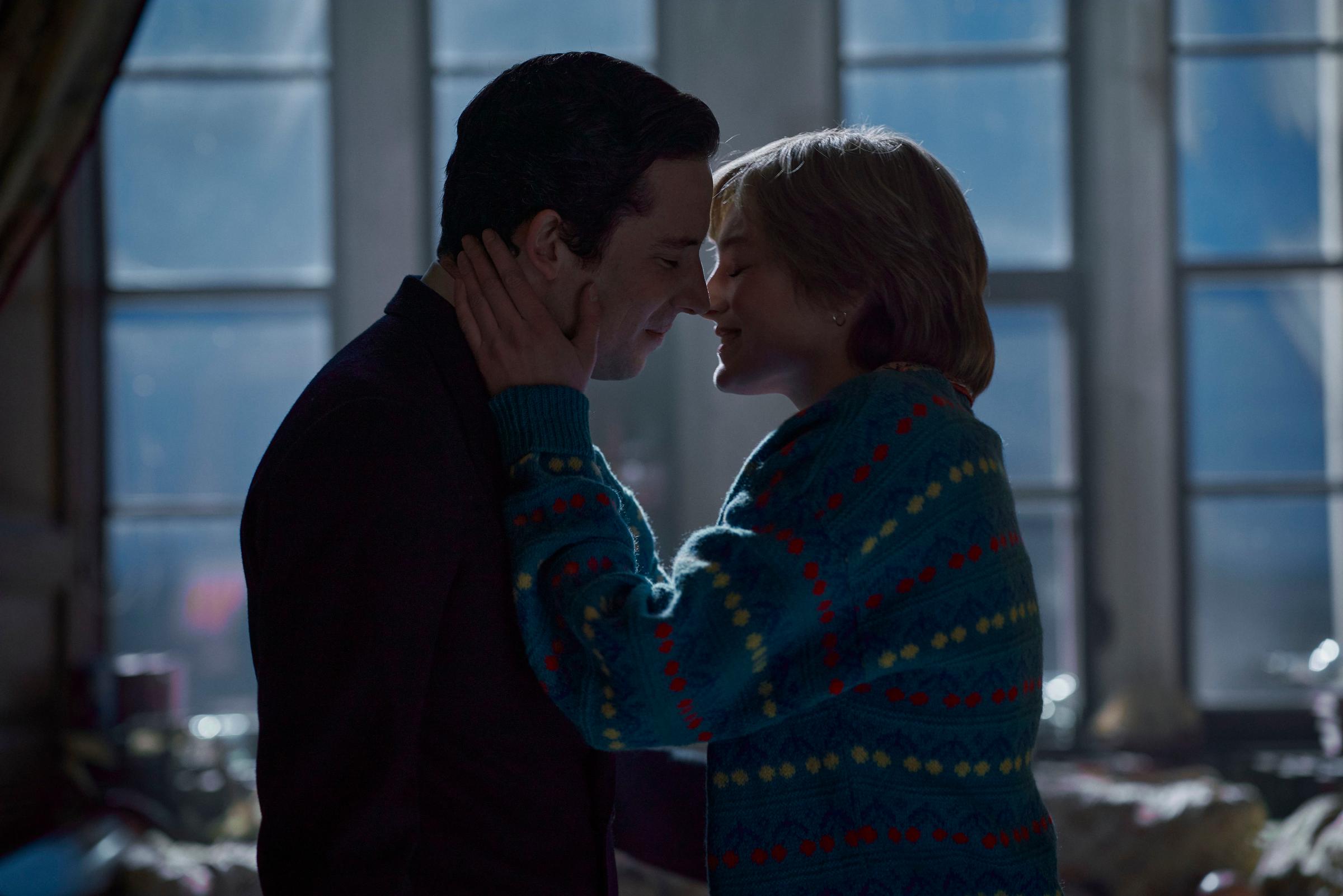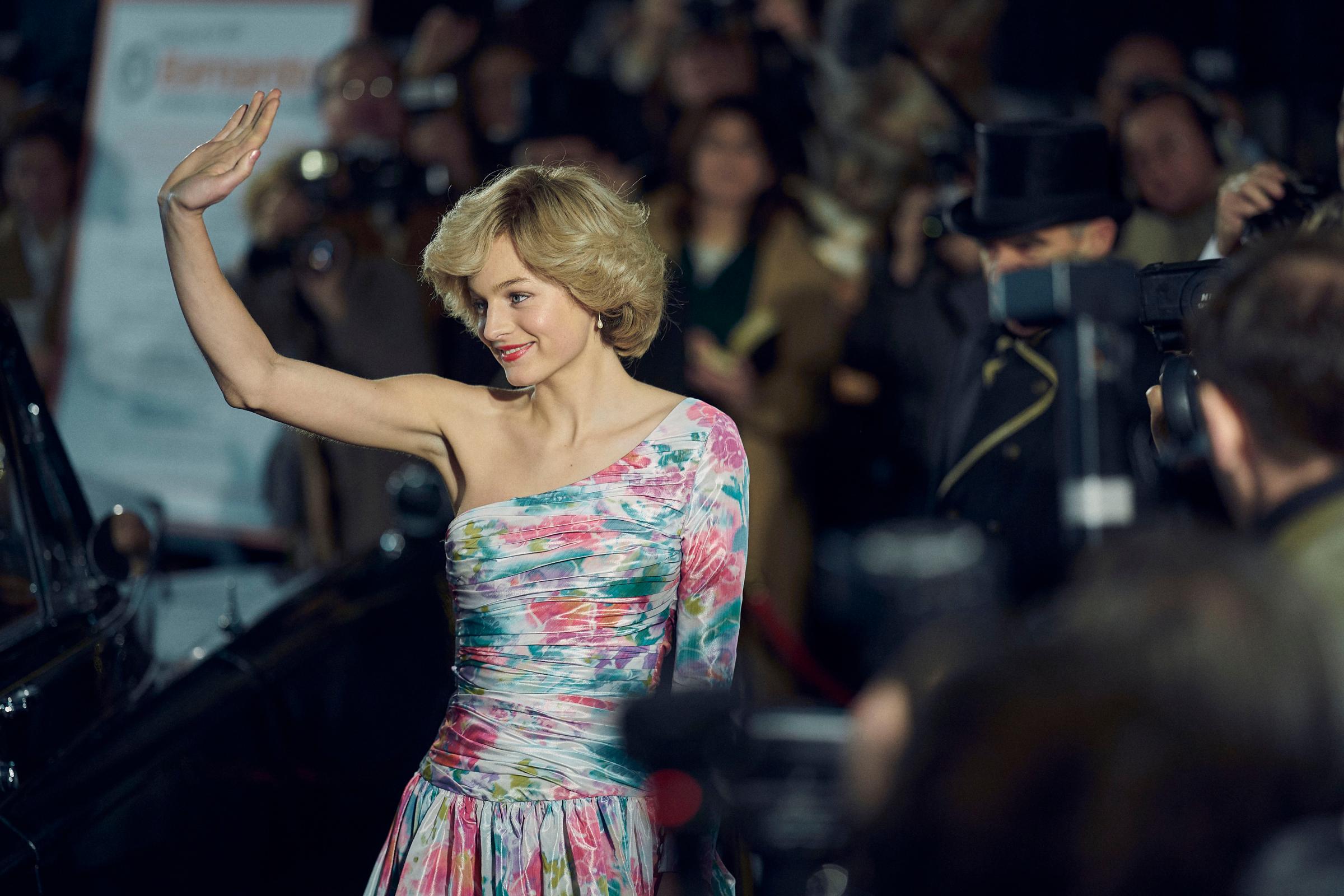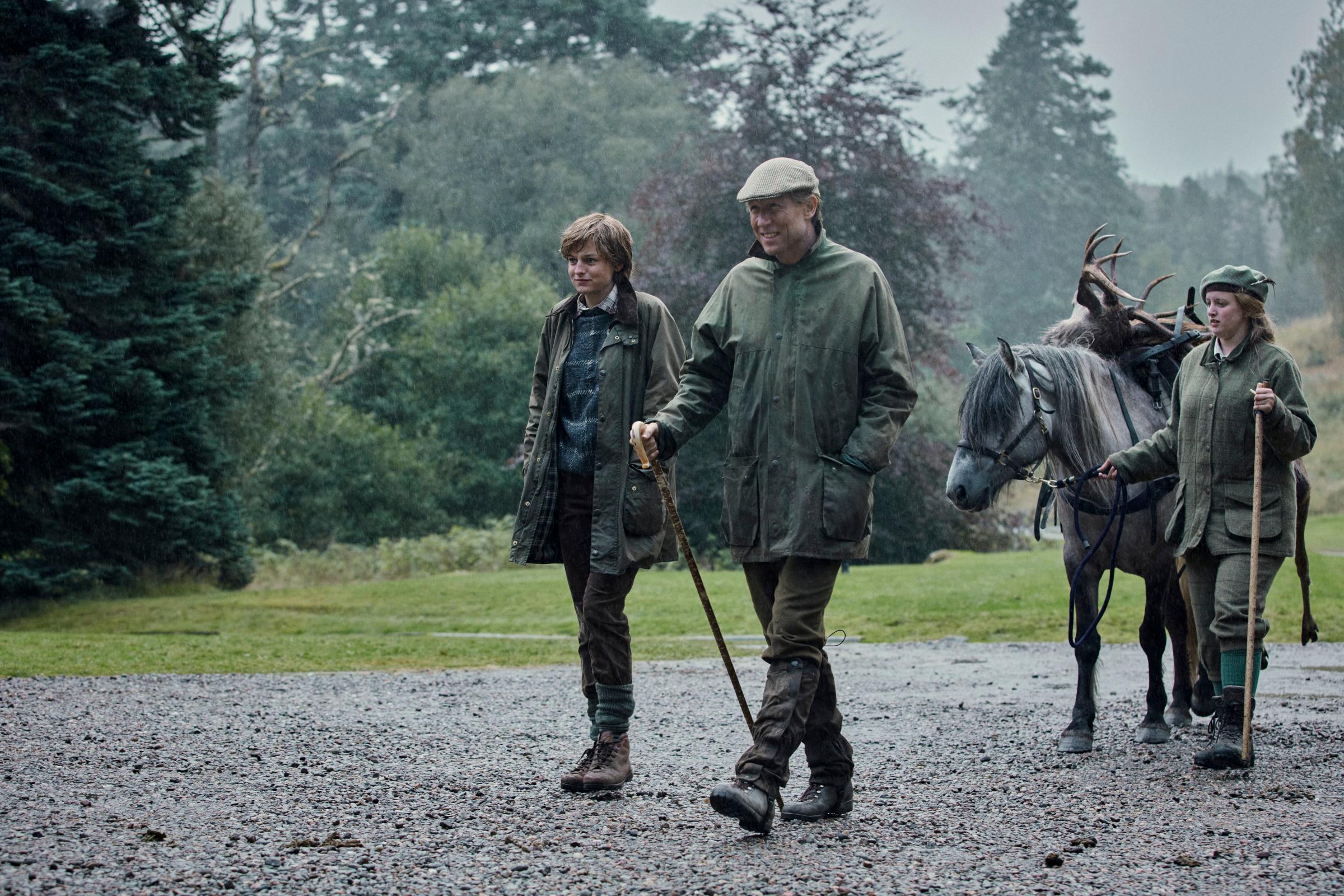For three seasons, The Crown has explored the same theme. When the first season premiered in 2016, showrunner Peter Morgan told TIME, “With the crown come a series of rules and expectations that might be quite out of step with the person who has the crown on their head. There is a constant duality between who you are as an individual and what the crown makes you become.”
Since, protocol has upset the personal lives of just about every member of the royal family. Princess Margaret fell for a divorced man she wasn’t permitted to marry. Prince Philip desired some semblance of freedom but instead lived in Elizabeth’s shadow. Prince Charles would really have preferred to attend a school where he wasn’t ignored or bullied, but politics demanded he attend schools he disliked. But in Season 4, the demands of duty finally break the royal family.
Enter Diana Spencer, the most highly-anticipated character in the show’s history. At the beginning of the new season, Charles honors the now-grand royal tradition of falling in love with someone he can’t marry (the already wed Camilla Parker Bowles) and instead proposes to Diana, a teenager whom he barely knows. Predictably, their marriage is miserable, and Charles continues to see Camilla behind Diana’s back. But unlike the couples who came before, Charles and Diana don’t just fester in their unhappiness. Their relationship turns explosive, and the royal family finally begins to face the consequences of their draconian rules about love, divorce and duty.
The fiction isn’t far from reality. Charles and Diana’s fights leaked into the tabloids and presaged their eventual divorce. Charles and Camilla’s affair also exploded into the headlines, years before they would finally marry. Here’s everything you need to know about the true story behind Charles, Diana and Camilla’s love triangle.
Why didn’t Charles marry Camilla in the first place?

Many historians have argued that the royal family could have avoided scandal had they only allowed the heir to the throne to marry his first love, Camilla Shand, later Camilla Parker Bowles. Charles and Camilla met in the summer of 1971, and though they spent just six months together, Charles was smitten.
But Camilla’s family did not have a title. (Diana, by contrast, was the daughter of an earl.) Nor did Camilla have Diana’s virginal reputation, a so-called problem that largely goes unspoken in The Crown. The royal family’s obsession with the virginity of the future princess was somewhat out of step with the modernity of the 1980s, but according to Tina Brown’s 2011 book The Diana Chronicles, it was of utmost importance to the family.
Camilla had dated several men by the time she began seeing Charles, including her future husband, Andrew Parker Bowles. Charles’ uncle, Lord Mountbatten, reportedly wrote in a letter to his nephew, “I think it is disturbing for women to have experiences if they have to remain on a pedestal after marriage.” Diana, by contrast, was at least presumed to be a virgin, in part because of her young age and lack of dating experience: Charles was her first real boyfriend.
But the biggest obstacle for Camilla and Charles’ relationship was Camilla herself. Camilla did actually seem to love both Charles and Andrew. As Brown wrote, “My own view is that the love of Camilla’s life was not Prince Charles but the man she married first—Andrew Parker Bowles … Her dalliance with Charles had been fun, flattering and sexy, but her friends knew all along that her consuming passion was Andrew.”
In Season 3 of the show, Lord Mountbatten arranges for Charles to be sent on a Navy mission to separate him from Camilla. In reality, it’s unclear whether the royal family actively plotted to separate the couple, but according to Brown, the royals did see Camilla as a “learning experience” for Charles and nothing more. In Charles’ absence, Camilla agreed to marry Andrew in 1973.
Even after Camilla married, Charles continued to phone her constantly and confide in her, according to Sally Bedell Smith’s biography, Prince Charles: The Passions and Paradoxes of an Improbable Life—the closest to an authorized biography as a book on a royal can be. Brown reports that Charles and Camilla resumed their affair in 1979 after the IRA killed Lord Mountbatten, a father figure for Charles. It was at this point, according to Brown, that the Palace worried about the future of the crown and began casting around for a future princess.
Why did Charles and Diana marry?

There was a significant age gap between 16-year-old Lady Diana Spencer and Charles, Prince of Wales, when they first met in 1977. As depicted in The Crown, Charles was dating Diana’s older sister, Sarah, but took a more serious interest in Diana as a potential match during the summer of 1980. At that time, there had been intense attention on Charles’ love life, given that he was over 30, had not yet married, and was the future heir to the throne. The couple became engaged after only a few months of dating, and Diana was quickly thrust into the limelight, leaving her West London flat with her friends and moving into Buckingham Palace, where according to Seward her life was incredibly lonely.
Stephen Bates, former royal correspondent for the Guardian newspaper and author of Royalty Inc., says that few people questioned the age disparity between the couple, and the royal family saw Diana as a breath of fresh air who could help revitalize their public image. But he adds that they didn’t prepare her properly for the pressures, expectations and overall intensity that being a member of “The Firm” entailed. “There was an air of desperation about the marriage,” Bates says. “The fact they scarcely knew each other was a big problem, because the royals were so desperate to seize this potential asset, that they didn’t question whether she was up to the immense pressure she was going to get.”
Did Charles and Camilla continue their affair after he got married?

Charles and Camilla briefly suspended their affair when Charles married Diana, but biographers debate just how long they hit pause on the romance. Diana recorded tapes for journalist Andrew Morton, transcripts of which he later published in 1992’s Diana: Her True Story. In those tapes, Diana recalled her growing suspicion that Charles and Camilla were still having an emotional affair: she discovered a personalized bracelet that Charles had bought for Camilla shortly before the wedding. Diana wanted to call off the wedding, but her sisters talked her out of it. Later, on their honeymoon, Charles wore cufflinks that Camilla had gifted him.
Bedell Smith pinpoints 1986 as the year that Charles and Camilla resumed their affair. In 1989, Diana confronted Camilla about the affair with Charles at a friend’s birthday party. Diana recalled the exchange in a series of recordings later published in Morton’s book: “I said, ‘I know what’s going on between you and Charles, and I just want you to know that.’ She said to me: ‘You’ve got everything you ever wanted. All the men in the world fall in love with you, and you’ve got two beautiful children, what more do you want?’ So I said, ‘I want my husband.’”
That same year, Charles and Camilla had an intimate phone conversation, in which the prince said he wished he “lived in her knickers.” A recording of the conversation leaked to the press in 1993, a few months after Diana and Charles announced their separation, jumpstarting what came to be known as “Camillagate.”
Did Diana have affairs?

The Crown shows Diana having her own affairs later on in the relationship, in particular with James Hewitt, who was the family’s former riding instructor. While Diana’s affairs weren’t publicly confirmed at the time, there was certainly speculation that she was not being faithful to Charles. News trickled out in the British tabloid press at the time about the affair with Hewitt, which lasted for five years between 1986 and 1991. A year after a book was written detailing her relationship with Hewitt, Diana herself confirmed the affair in the world-famous 1995 Panorama interview, which has recently been back in the headlines in Britain.
Newspapers also linked Diana romantically to several other men during her marriage to Charles, some of whom were married, including art dealer Oliver Hoare, her bodyguard Barry Mannakee, and a car dealer named James Gilbey. Intimate phone conversations between Gilbey and Diana were leaked to the press in 1992, in a scandal dubbed “Squidgygate” for Gilbey’s nickname for Diana.
“What they really need is a holiday from the forever bickering British tabloids,” reported TIME in May 1987, commenting on one of Charles and Diana’s highly scrutinized trips abroad. Royal biographer Ingrid Seward recalls the height of the animosity between the Charles and Diana “camps” heightening at around this time, after photographs of the pair visiting people affected by floods in Wales showed that they both arrived and left separately. “I remember writing about the talk of the dinner tables of London, and that was all anyone seemed to want to talk about,” Seward says.
What was Camilla and Diana’s relationship like?

“Well, there were three of us in this marriage, so it was a bit crowded,” Diana said in the 1995 interview with BBC that made headlines around the world.
In The Crown, Camilla Parker Bowles is depicted as encouraging Charles to stick with his marriage to Diana. According to Brown, Camilla did not see Diana as a threat. In the words of Camilla’s former brother-in-law, Richard Parker Bowles, “[Camilla] initially encouraged the relationship between Charles and Diana because she thought Diana was gormless… Camilla knew that as a woman with a past she could never be accepted as Charles’ wife. But she also thought Diana was someone whom she could manipulate.”
The Crown also depicts Diana and Camilla having a rather awkward lunch in Charles’ absence immediately after their wedding in 1981. According to a biography of Charles titled The Man Who Would Be King, Camilla did invite Diana out to lunch with “genuinely friendly intentions,” and said that she would “love to see the ring.” However, Seward says that there was antipathy between the two since before Charles and Diana’s wedding, and that Diana had never liked Camilla as she always was suspicious of Camilla’s relationship with Charles. “She suspected [Charles and Camilla’s affair] for a long time, and she allowed it to become an obsession. Every time Charles was out of sight, she thought he was somewhere with Camilla, but she didn’t know for sure,” Seward says.
How did the royal family react to the breakdown of the marriage?

The Crown’s final Season 4 episodes show Olivia Colman’s Queen Elizabeth attempting to intervene and mediate in Charles and Diana’s marital problems, before eventually losing her temper at Charles in particular for not trying harder to make the marriage work and seeking a divorce. While we don’t know for certain what those scenes were like behind the closed doors of Buckingham Palace, there is reason to believe that the royal family were not happy about the breakdown in Charles and Diana’s relationship.
The traditional “never complain, never explain” motto thought to be one of the guiding principles of the royal family’s public image was shattered when relations broke down between Charles and Diana. According to TIME in 1987, “London’s tabloids have been in the most vicious royal feeding frenzy on record,” searching to widen the cracks in the royal couple’s marriage.
Seward, author of the new biography Prince Philip Revealed, says that the family’s patriarch was extremely angry when Diana and Charles’ differences became irreconcilable. “[Philip] was furious. He was angry with his wife, and he was angry with his son for not getting a grip on the situation sooner, and he was angry with Diana,” Seward says. “He wrote to Diana and said I just want to remind you that being a member of the Royal Family is not a popularity contest, it’s about all of us working together for the good of the institution.”
Correction, Nov. 16
The original version of this story misstated Richard Parker Bowles’ relationship to Camilla. He is her former brother-in-law, not her brother.
More Must-Reads from TIME
- Caitlin Clark Is TIME's 2024 Athlete of the Year
- Where Trump 2.0 Will Differ From 1.0
- Is Intermittent Fasting Good or Bad for You?
- The 100 Must-Read Books of 2024
- Column: If Optimism Feels Ridiculous Now, Try Hope
- The Future of Climate Action Is Trade Policy
- FX’s Say Nothing Is the Must-Watch Political Thriller of 2024
- Merle Bombardieri Is Helping People Make the Baby Decision
Write to Eliana Dockterman at eliana.dockterman@time.com